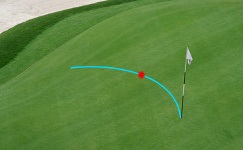
Golf’s major equipment makers spend much of their marketing budgets selling drivers. So it’s no surprise that new drivers are by far the most expensive clubs – or that most amateurs reflexively reach for the big stick on every par 4 and par 5.
For all the distance gains brought about by modern technology, accuracy – not length – remains the most important driving skill. That’s especially true for amateurs, who lack the prodigious power that lets professional golfers smash the ball past trouble spots.
But the pros recognize there are times when hitting the driver is either too risky or simply unnecessary. That’s when they’ll choose a fairway wood, hybrid or even an iron to position the ball in the right spot on the fairway.
Pros don’t always hit the longest club for their second shots on par 5s, either. Nor do they aim at every flagstick with their irons, or always attempt a miraculous recovery from trouble. Instead, they plot their way around the course, attacking when the odds are favorable and playing safely when risk outweighs reward.
Course management is a subtle and overlooked but vitally important part of golf. Learn the pros’ strategy methods and you’ll save strokes without making a single swing change. In part I of this two-part feature, we’ll study how pros manage the game from tee-to-green. (Part II focuses on the short game and putting.)
Why It’s Important:

Nothing adds shots to your scorecard faster than hitting the ball into a hazard, the woods or out of bounds. Sometimes these mistakes are a matter of execution; perfect strategy is often undermined by a bad swing. Other times, steering clear of disaster is as simple as picking the right club.
Practicing sound course management can greatly lower your stress level, too. Most golfers tense up over risky shots, decreasing their chance of success. By limiting the degree of difficulty, you’ll relax and swing more freely.
Who You Should Watch:
In historical terms, Ben Hogan and Jack Nicklaus rank among the greatest at managing the course. Among today’s pros, Tiger Woods has flashed strategic brilliance on many occasions. Zach Johnson’s tactical approach helped him win the 2007 Masters despite never reaching a par 5 in two shots.
Generally speaking, professionals are highly adept at this aspect of the game. Here are a few things to study when viewing tournament golf:
- Their club choices on tight par 4s. Unless the hole is exceptionally long, most pros will hit a shorter club than the driver to better avoid water, thick rough or other obstacles
- How they play away from difficult pin placements: Few pros will play directly at a hole cut close to a deep bunker or water, aiming instead for the center of the green. The exception is when they’re hitting a wedge, which delivers greater accuracy, height and backspin than longer clubs.
- When they go for it on par 5s: Assuming they’ve got the power to reach the green, two things will discourage a pro from giving it a go: a hazard requiring a long carry, or major trouble very close to the green’s edge. In general, pros play par 5s as aggressively as possible.
- Where they lay up: On par 5s, many amateurs automatically reach for the 3-wood for a second shot that has no chance of hitting the green. Pros prefer to lay up to a distance that gives them the best chance on the next shot. For example, if a pro hits a full sand wedge 100 yards, he’ll lay up using the club that reaches that spot. The same goes for a short par 4 where driver isn’t necessary.
Apply It to Your Game
Follow these tips to manage the course like a pro:
- Don’t hit driver if a hole is very tight, unless you are extremely accurate with that club.
- Play aggressively whenever possible on par 5s and short par 4s. If the penalty for a missed shot is light, go for it.
- When laying up, determine how far you need to hit the ball to present the best opportunity on your next shot. For example, if you’re 260 yards from the green and want to be 100 yards for your next shot, pick your 160-yard club for the lay-up.
- On approach shots, aim for the middle of the green any time there’s trouble near the flag.
- When the pin is placed near the edge of a green, play to the wider side. For instance, aim to the right of a pin that’s close to the left edge.
- Limit the damage when shots go astray. Pitch back to the fairway from trees or deep rough.Q: What is golf course management? A: Golf course management refers to the strategic decision-making and planning a golfer employs during a round to navigate the course efficiently and optimize their scoring potential. It involves selecting the right shots, clubs, and tactics to play to one's strengths and avoid unnecessary risks.
Q: Why is golf course management important in improving a golfer's performance? A: Golf course management is crucial in improving a golfer's performance because it helps them make better decisions on the course. By understanding their abilities and the layout of the course, golfers can play to their strengths and minimize mistakes, ultimately leading to lower scores.
Q: What are some key factors to consider in golf course management? A: Some key factors to consider in golf course management include assessing the layout and conditions of the course, knowing the distances and hazards, understanding wind and weather effects, and strategizing for different hole types and pin placements.
Q: How can golfers assess risk and reward on the course when making decisions? A: Golfers can assess risk and reward by weighing the potential benefits of a shot against the potential risks and consequences. They should consider their skill level, the difficulty of the shot, and the potential consequences of missing before making a decision.
Q: How can golfers develop a course management strategy that suits their game? A: Golfers can develop a course management strategy by gaining experience on the course and learning from previous rounds. Analyzing past performances, seeking advice from experienced golfers or instructors, and playing practice rounds can all contribute to developing a personalized approach.
Q: Is course management more important for high-handicap or low-handicap golfers? A: Course management is important for golfers of all skill levels. While high-handicap golfers may benefit from minimizing risky shots and focusing on safe plays, low-handicap golfers can use strategic approaches to take advantage of their skills and score more effectively.
Q: How can golfers adapt their course management strategy during a round based on performance and changing conditions? A: Golfers should be flexible in their course management strategy during a round. They can adjust their approach based on how they are performing, the conditions they encounter, and the shots that are working best for them that day.
Q: Can course management help golfers manage their emotions and maintain composure during a round? A: Yes, effective course management can help golfers manage their emotions by keeping them focused on their game plan and minimizing impulsive decisions. Staying committed to a well-thought-out strategy can lead to greater composure and confidence on the course.
Q: How does golf course management vary from one golf course to another? A: Golf course management can vary from one golf course to another due to differences in layout, design, hazards, and overall difficulty. Golfers need to adapt their strategies to the unique challenges presented by each course they play.
Q: Can golfers use technology, such as GPS devices or course management apps, to enhance their decision-making on the course? A: Yes, golfers can use technology like GPS devices or course management apps to enhance their decision-making. These tools provide valuable information about distances, hazards, and course layouts, helping golfers make informed choices.
Q: Is there a one-size-fits-all approach to golf course management, or is it individualized for each golfer? A: Golf course management is individualized for each golfer. Each player's strengths, weaknesses, and playing style are different, so their course management strategies should be tailored to suit their unique game.





